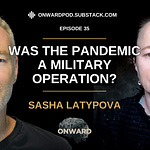In this episode of Onward Podcast, I reconnect with Jamie Andrews from the Virology Control Studies Project to explore the role of PCR testing in the construction of modern pandemics, and where it’s headed next.
If you haven’t listened to our earlier two-part conversation, please the links below. That series laid the groundwork with a deep dive into virology’s foundational assumptions, the myth of contagion, and the implications of Jamie’s control experiments on sterile cell cultures.
The Truth About Contagion, Viruses & Germ Theory - Part 1
Many of my followers and students have asked me to comment on the ongoing germ vs terrain theory/ “viruses don’t exist” debate. I first explored this topic with Dr Tom Cowan and Sally Fallon-Morell on my previous podcast, Beyond Health in March of 2021. You can
The Truth About Contagion, Viruses & Germ Theory - Part 2
Jamie Andrews from “The Virology Control Studies” project is back for part 2 of this series. In part 1 we laid the ground work and did an overview of the concepts of contagion, germ vs terrain theory, viruses and the field of "virology" as a whole.
In today’s episode, we follow the next logical thread and the tool that is propping up the emerging Pandemic Industry: the PCR test itself.
PCR testing — marketed as a precise and accurate diagnostic tool — has become the gatekeeper of not only disease identification but of sweeping policy, economic disruption, and even food system control. Whether it’s farm culling in Western Canada (see the ongoing ostrich farm case), travel restrictions, or vaccine rollouts, it all hinges on one thing: a test.
But what if the test is fundamentally flawed?
Before I dive into the highlights, I would strongly suggest that you read Jamie’s deep-dive into the PCR test here:
Key Points of Discussion for This Episode:
Revisiting the Virology Control Studies and Public Response: We recap the findings that emerged from the Virology Control Studies, including how sterile cell cultures still produced viral-like particles when starved and stressed—calling into question the assumption that these effects are caused by infectious agents. We also reflect on how these results were received, not only by the public but by scientists (both supportive and critical), and what it revealed about the state of institutional science.
The German Court Case That Quietly Undermined Virology: We dig into a pivotal legal case in Germany involving Dr. Stefan Lanka and the question of whether the measles virus has ever been proven to exist. The ruling affirmed that no single paper proves the existence of the virus, and notably rejected the genome sequence paper as definitive evidence. This case, which reached the country’s highest court, has gone largely unacknowledged, but carries major legal and scientific implications.
PCR Testing: What It Claims vs. What It Actually Does: We break down how PCR testing is supposed to work according to mainstream science (amplifying specific nucleotide sequences using primers and fluorescent dyes). Then we contrast that with what’s actually being measured in practice. Based on Jamie’s experiments and what we’ve seen in the literature, electrical charge and pH levels appear to be the real variables influencing test outcomes. From mineral content in the body to ionized water, and even warnings for patients to avoid mineral water before testing, it’s clear something much more basic is being measured, not genetic sequences as advertised. The claim that PCR identifies infectious pathogens completely collapses when negative controls (nuclease-free water) routinely test “positive,” and when lab techs report that bacterial or unrelated samples still generate amplification. This information is especially important considering the entire Pandemic Industry is built around PCR testing
PCR and the New Era of Preemptive Diagnostics: We explore how PCR is already being positioned as a tool for early cancer detection, despite having never been designed or validated for this purpose. We discuss how this paves the way for mRNA-based personalized “treatments” based on early diagnostics, which may or may not correlate with any actual illness or pathology.
How the PCR Test Traps People in the Disease Model: We reflect on the psychological impact of PCR-driven diagnostics, particularly in HIV-positive individuals. Jamie shares insights from people who have stopped antiretroviral medications and experienced improved health - some even testing negative. We discuss how this challenges the dominant medical narrative and raises critical questions about how PCR is being used to create and sustain disease identities.
The Real-World Consequences: Ostrich Farms, Food Supply, and Bill C-293: We zoom out from the lab to real-life application, specifically the recent Canadian ostrich farm case, where PCR testing was used to justify the culling of healthy animals. We connect this to Bill C-293 and the World Health Organization’s One Health surveillance framework, which aims to test humans, animals, and the environment for so-called “pathogens with pandemic potential.” We see this as a major red flag for farmers, food security, and bodily autonomy.
The Bigger Picture
If PCR is being used to fabricate disease narratives - from “asymptomatic pandemics” to early-stage cancers—then it’s not just a medical issue. It’s a civilizational risk. PCR is becoming the digital switch that controls your mobility, access to healthcare, and now even your right to farm or own livestock.
The implications are staggering:
A test that can’t be consistently replicated…
Being used to justify lockdowns, mandates, farm quarantines, culling of animals and forced medication…
And soon to underwrite an entirely new era of personalized AI-driven mRNA treatments.


















Share this post